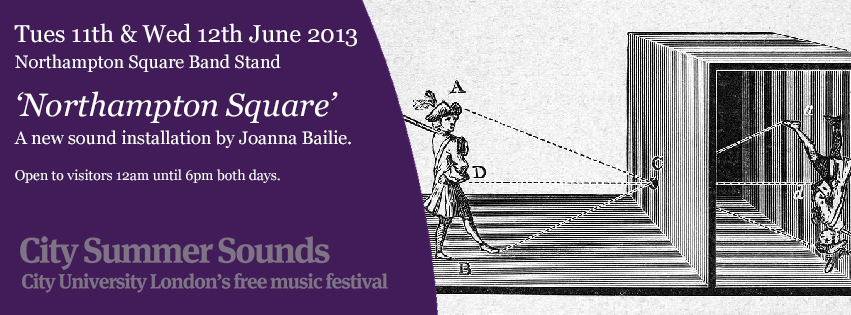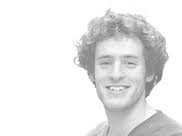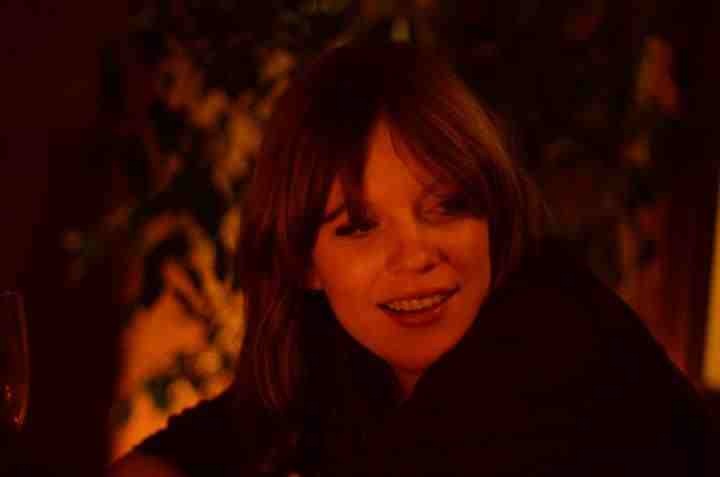
On Tuesday 11th and Wednesday 12th June Joanna Bailie brings her camera obscura inpsired installation to City Summer Sounds festival. We managed to find some time to chat to her about the work as she makes her final preparations:
Your installation ‘Northampton Square’ employs a large camera obscura. For those that don’t know, how does a camera obscura work?
Camera obscura means “dark room” in Latin, but not the kind of dark room in which one develops photographs. In fact it’s a very large version of the inside of a camera — a dark space with a hole cut in one side to let the light (and the image) through, plus a surface onto which to project this image. It works because light travels in straight lines. Of course I only have a projection screen, not a surface covered in chemicals that react to the light, so I cannot preserve any images, they must be experienced live by the audience.
You’ve had a number of works in the past few years focusing on the concept of a camera obscura. What was it that drew you to this medium?
Yes, perhaps I’m a little obsessed. I saw my first camera obscura at an exhibition at the Hayward Gallery on art and illusion about 10 years ago. It was a shed sitting outside the building with a view on Waterloo Bridge. I didn’t know what a camera obscura was at that time, and I was quite taken aback by the image of London in motion, upside down. There was a peculiar quality to the image — I thought it was the most vivid thing I had ever seen. It’s absolutely pure projection of continuous reality, unlike a film with its 24 images per second. A camera obscura has no frames, it’s way beyond HD. It has a level of resolution that HD will never attain. I never get tired of making camera obscuras nor of the effect they have (on me).
Before this installation I made two pieces using a camera obscura, the first with a German scenographer called Christoph Ragg and the second with a string trio. It’s important to say that both these pieces used a theatrical camera obscura, meaning that the bright space that was projected into the dark one, was an interior and thus had to be lit by a lot of theatre spots in order to be bright enough to create a good image. Northampton Square will be lit by the sun of course.
The audience gets a very intimate experience here, getting right inside the camera itself. What do you hope an audience member will gain from ‘Northampton Square’?
First of all I hope, like me, they’ll enjoy the incredibly vivid quality of the image. It’s not intended to be a didactic work at all, but people often end up learning about how a camera works for the first time and they can’t believe that all it takes is a dark and light space with a hole between. It’s a bit counter-intuitive, you might expect the hole to simply let a ray of light into the dark room, which makes what happens that much more amazing. The sound is another thing altogether. It’s a bit more intimate and complex and makes use of a freezing process where the live sound is periodically frozen into a sustained sound. The intention is to make the audience listen to the live sound in a different way, to hear it as a potential music and to experience the contrast between it and the image. The sound is broken up, discrete and abridged while the image, as I’ve already mentioned, is pure continuity.
This installation in particular plays on the boundaries between music and non-music, and unlike the previous camera obscura works relinquishes a certain amount of control to the world outside the camera. Is this balance of music and non-music something that you have focused on before, and what inspired you to focus on this?
The idea of using real life as the basis for some kind of artistic narrative has been the basis of many of my recent works using field recordings. But of course with field recordings you can select what you use from all the sound you’ve captured. In the installation the sound and image are always at the mercy of what happens because they are live. My idea is to try to compose the real life coming into the installation by making a score: a set of (almost) live sound manipulations that the computer has to perform on the microphone feed. The score is quite elaborate and works fairly well regardless of what is going on outside. Occasionally something very special happens at exactly the right time and it’s all just chance (by the way, I recommend coming to see/hear the installation exactly on the hour for reasons that will become obvious!). You could say that the installation is all about creating a frame for reality via the projection screens that physically frame the image, and the computer manipulations that successively frame and unframe the sound.
What’s next for you and the camera obscura project?
Well Northampton Square will be the third incarnation of the installation (the first and second were in Brussels and Belfast). The fourth is set for Brussels again during the Tuned City Festival. That one will look onto a very busy road and will be very different from Northampton Square. Following that I’ll be creating a theatre piece about condensing the last 100 years of history with a German theatre-maker and actress called Katja Dryer, and working on my PhD of course!
You can find out more about Joanna Bailie here: http://joannabailie.com/
The installation ‘Northampton Square’ will be open between the hours of 12am and 6pm in Northampton Square Bandstand on Tuesday 11th and Wednesday 12th June 2013.
For more information about City Summer Sounds head to: http://www.city.ac.uk/city-summer-sounds
Or follow us on facebook: http://facebook.com/CitySummerSounds









